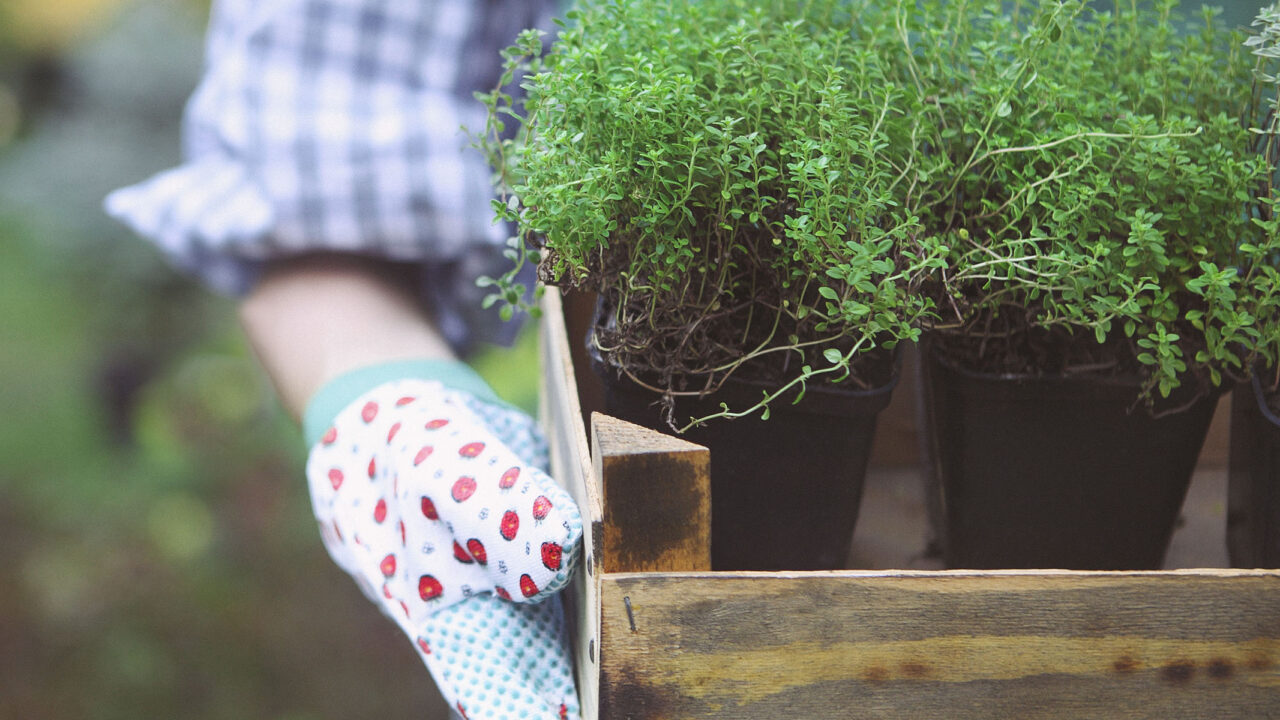Looking for plants that are suited for our hot Texas summers that don’t require much watering?
Here is our list of ten drought-tolerant native plants for Houston. While most do well in full sun, we’ve included a few that do well in shade too.
What is a native plant? Plants are native if they have occurred naturally for thousands of years in a region, ecosystem, or habitat without human introduction. These plants have formed symbiotic relationships with native wildlife over thousands of years, meaning that many native animals and insects are dependent on these particular species to survive. Native plants are always the best bet when it comes to supporting our local wildlife. When you plant a garden, it is not just for you – it is a habitat for all living things around you.
1 Texas Lantana (Lantana urticoides)
A spreading shrub producing showy cymes of trumpet flowers that emerge yellow and mature to orange, then red, over foliage that is bright green; grows in a wide range of soils and is very drought tolerant.
Texas Lantana is a multi-stemmed deciduous shrub with a more or less rounded form. Its average texture blends into the landscape, but can be balanced by one or two finer or coarser trees or shrubs for an effective composition.
This is a relatively low maintenance shrub, and should not require much pruning, except when necessary, such as to remove dieback. It is a good choice for attracting birds and butterflies to your yard but is not particularly attractive to deer who tend to leave it alone in favor of tastier treats. Texas Lantana is recommended for the following landscape applications; Mass Planting, Border Edging, General Garden Use, Container Planting, Hanging Baskets
Other names: Calico Bush, West Indian Shrub Verbena
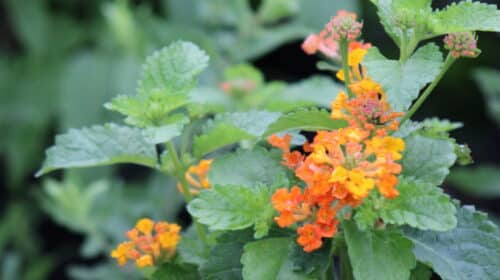
2 Black-eyed Susan (Rudbeckia fulgida ‘Goldsturm’)
Black-eyed Susan has masses of beautiful gold daisy flowers with dark brown eyes at the ends of the stems from mid-summer to early fall, which are most effective when planted in groupings. The flowers are excellent for cutting. Its serrated pointy leaves remain dark green in color throughout the season.
It is an herbaceous perennial with an upright spreading habit of growth. Its medium texture blends into the garden but can always be balanced by a couple of finer or coarser plants for an effective composition.
This is a relatively low maintenance plant and should be cut back in late fall in preparation for winter. It is a good choice for attracting butterflies to your yard but is not particularly attractive to deer who tend to leave it alone in favor of tastier treats. It has no significant negative characteristics. Black-eyed Susan is recommended for the following landscape applications, Mass Planting, General Garden Use, Container Planting
Other names: Orange Coneflower
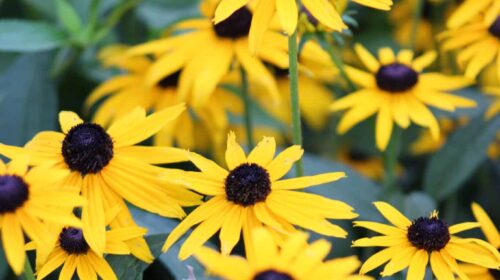
3 Four-Nerve Daisy (Tetraneuris scaposa)
Four-nerve Daisy features dainty yellow daisy flowers with gold centers rising above the foliage from late spring to early summer. Its attractive tiny grassy leaves remain bluish green in color throughout the season. A cheery, bright yellow rebloomer, perfect for xeriscapes, alpine and rock gardens; resistant to critters and attractive to butterflies.
Four-nerve Daisy is an herbaceous perennial with a mounded form. It brings an extremely fine and delicate texture to the garden composition and should be used to full effect. Four-nerve Daisy is recommended for the following landscape applications; Mass Planting, Rock/Alpine Gardens, Border Edging, General Garden Use, Naturalizing and Woodland Gardens
Other names: Thrift-leaf Perky Sue, and Slender-stem Bitterweed, Hymenoxys scaposa
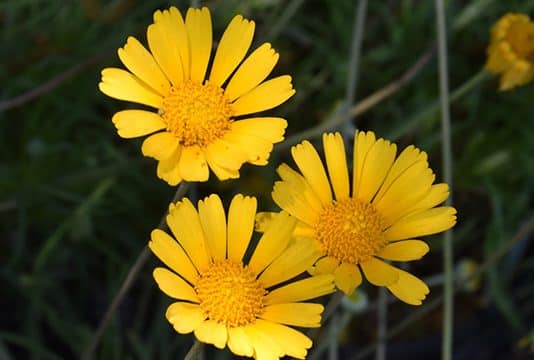
4 Autumn Sage (Salvia greggii)
Blooms in a variety of colors are borne on racemes above the beautiful green foliage on this late blooming perennial; though less hardy to temperature, it is resilient to disease, pollution and sea salts; excellent for containers and rock gardens.
Autumn Sage is an herbaceous evergreen perennial with an upright spreading habit of growth. Its medium texture blends into the garden but can always be balanced by a couple of finer or coarser plants for an effective composition.
This is a relatively low maintenance plant and should only be pruned after flowering to avoid removing any of the current season’s flowers. It is a good choice for attracting bees, butterflies and hummingbirds to your yard, but is not particularly attractive to deer who tend to leave it alone in favor of tastier treats.
Autumn Sage is recommended for the following landscape applications, Mass Planting, Border Edging, General Garden Use, Container Planting
Other names: Gregg’s Sage, Texas Sage, Cherry Sage
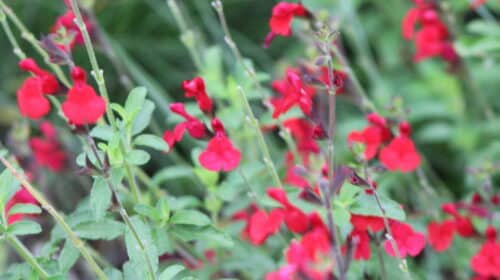
5 Gulf Coast Muhly (Muhlenbergia capillaris)
Gulf Coast Muhly Grass features airy plumes of pink flowers with rose overtones rising above the foliage from late summer to mid-fall. The tan seed heads are carried on showy plumes displayed in abundance in late fall. Its grassy leaves remain dark green in color throughout the season. It is a dense herbaceous perennial grass with an upright spreading habit of growth. Its relatively fine texture sets it apart from other garden plants with less refined foliage.
This is a relatively low maintenance plant and is best cleaned up in early spring before it resumes active growth for the season. Deer don’t particularly care for this plant and will usually leave it alone in favor of tastier treats. Provides cover for small animals, birds, and other wildlife to hide from predators. Larval host: Orange Skipperling.
Gulf Coast Muhly Grass is recommended for the following landscape applications; Mass Planting, Rock/Alpine Gardens, General Garden Use, Groundcover, Container Planting.
Other names: Pink Muhly Grass, Gulf Muhly
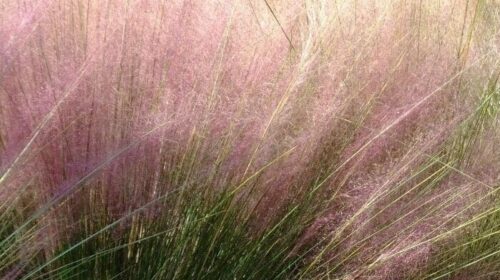
6 Pride of Houston Yaupon Holly (Ilex vomitoria ‘Pride of Houston’)
Makes a great landscape accent plant with its graceful, upright form; volumes of bright red berries that persist into the winter and attract birds; does best in evenly moist, acidic soil but is drought tolerant; can be shaped into a small tree.
Pride Of Houston Yaupon Holly is a dense multi-stemmed evergreen shrub with an upright spreading habit of growth. Its relatively fine texture sets it apart from other landscape plants with less refined foliage. This is a relatively low maintenance shrub and is best pruned in late winter once the threat of extreme cold has passed.
Pride Of Houston Yaupon Holly is recommended for the following landscape applications; Accent, Mass Planting, Hedges/Screening, Container Planting.
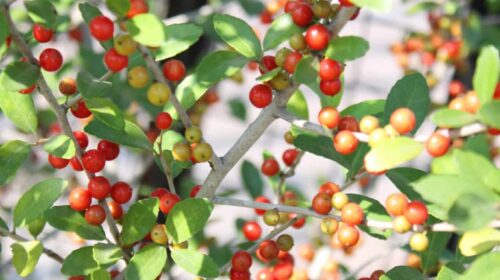
7 Turk’s Cap (Malvaviscus arboreus var. drummondii)
An interesting sub-shrub variety producing clusters of red flowers in late summer through fall; evergreen in warm, frost-free climates. Turk’s Cap features showy clusters of scarlet tubular flowers at the ends of the branches from mid-summer to early fall. The fruits are showy red drupes carried in abundance in late fall. It has green foliage with grayish green undersides. The round palmate leaves remain green throughout the winter.
This is a relatively low maintenance shrub, and should be cut back in late fall in preparation for winter. It is a good choice for attracting butterflies and hummingbirds to your yard. It has no significant negative characteristics.
Other names: Drummond Wax Mallow, Texas Mallow, Sleepy Hibiscus
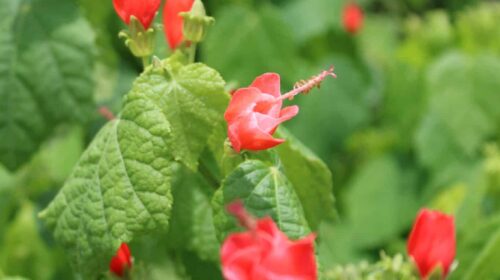
8 Texas Kidneywood (Eysenhardtia texana)
An amazing native shrub that can be found growing in front of the nursery. Texas Kidneywood is a must-have plant for pollinator gardens, xeriscape beds and more. The leaves have a tangerine scent when crushed.
Although Texas kidneywood is in the same family as acacias and mimosas, it does not have their characteristic thorns. It blooms intermittently from April to October, especially after rains. Its heaviest blooming period occurs late August to September. Texas kidneywood grows in rocky limestone soils from the Rio Grande Plains to the Edwards Plateau and Trans-Pecos. Larval host: Dogface Butterfly.
Fun fact- The heartwood of Kidneywood is reddish-brown and when soaked in water it produces a golden-yellow color used for dye.
Other names: Bee Brush, Vara Dulce, Palo Dulce
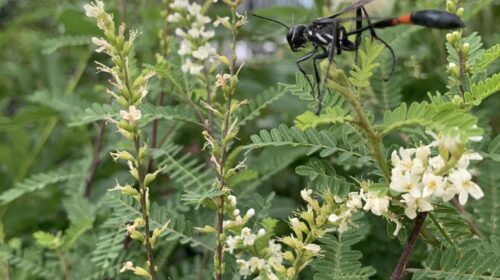
9 Flame Acanthus (Anisacanthus quadrifidus ‘var. wrightii’)
A beautiful native shrub of south-central Texas, producing vivid red-orange tubular flowers from late spring to fall; very adaptable and drought tolerant; great for heavy soils or growing in containers; a fine landscape specimen plant. It is a good choice for attracting butterflies and hummingbirds to your yard but is not particularly attractive to deer who tend to leave it alone in favor of tastier treats.
Flame Acanthus is recommended for the following landscape applications; Mass Planting, Hedges/Screening, Rock/Alpine Gardens, Container Planting.
Other names: Desert Honeysuckle, Mexican Flame, A. wrightii
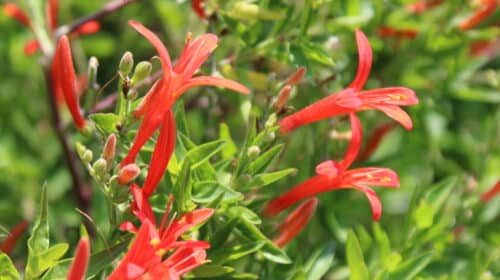
10 Texas Rock Rose (Pavonia lasiopetala)
A native, upright shrubby perennial, producing pretty rose-pink flowers from spring to fall; extremely drought tolerant, thriving in hot, dry areas; a great addition to beds, rock gardens or containers.
This shrub will require occasional maintenance and upkeep and should only be pruned after flowering to avoid removing any of the current season’s flowers. It is a good choice for attracting butterflies and hummingbirds to your yard. Rock Rose is recommended for the following landscape applications; Rock/Alpine Gardens, General Garden Use, Naturalizing and Woodland Gardens, Container Planting.
Other names: Wright Pavonia, Texas Rock Rose, Pavonia wrightii
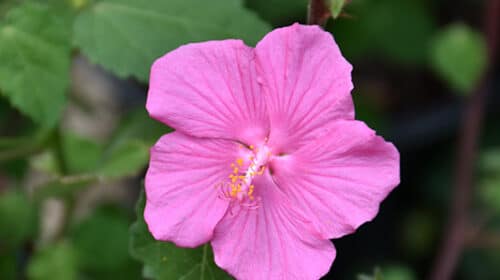
This list is some of our favorite drought-tolerant native plants. There are lots more that are suitable for Houston area gardens. Want to learn more about native plants? Come to Buchanan’s.
If you want a low maintenance, beautiful garden – start with natives. It’s not too late to plant. Visit Buchanan’s Native Plants today and our native plant experts will help you pick out the right plants for your garden.
Here are a few helpful links about native plants for Texas:
Native Plant Society of Texas
Explore plants at the Wildflower Center
